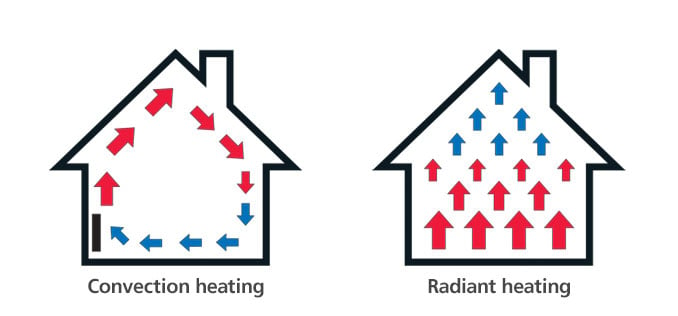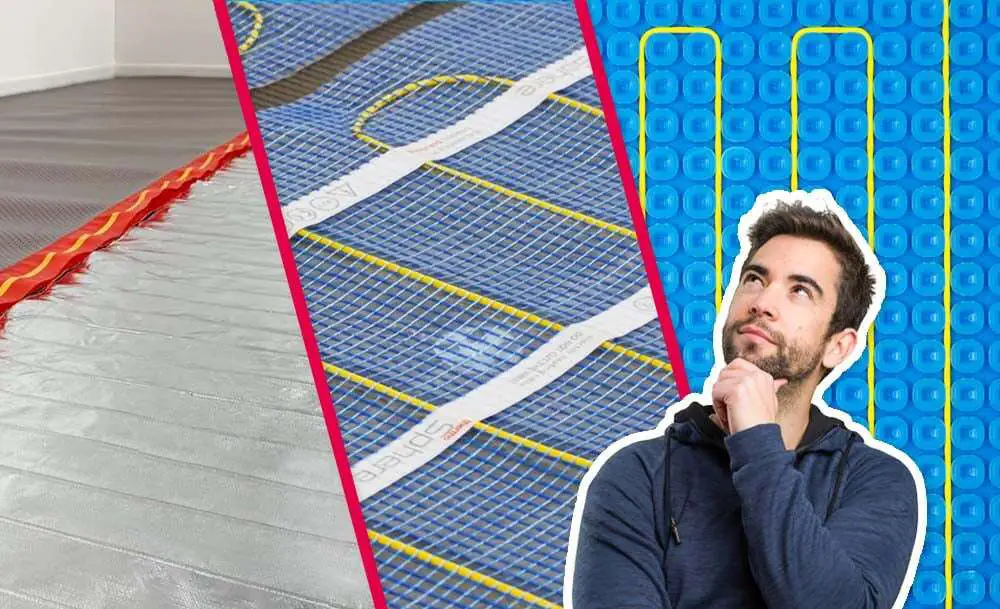14 min read
What electric underfloor heating system should I choose?
So, you’ve completed your research on electric underfloor heating and have decided that it’s the perfect fit for your project. But, with so much...

If you’ve landed here, we suspect you’re considering electric underfloor heating as the heating source for your next room makeover? This article will guide you through the essentials of electric underfloor heating, helping you decide if it really is the right choice for you.
We'll cover
The read time for this article is roughly 5 minutes. Ready? Let’s begin...
What is underfloor heating?
Electric underfloor heating systems consist of electric heating cables, either in a loose lay format or pre-spaced in mats. This is then, as the name suggests, installed within the floor underneath your floor finish. When the system is turned on, the cable heats up, transferring heat upwards via conduction heating (with insulation) and evenly distributes heat throughout your room. Alongside additional insulation boards and intuitive thermostats you can design a system that is tile warming, through to a whole zonal house heating setup. With no need for radiators, it also frees up wall space, giving you design freedom to create breath-taking spaces.
Energy and heating efficiency
Electric underfloor heating systems are highly efficient and operate at lower temperatures compared to traditional radiators but provide the same level of comfort. This is because the heat is spread uniformly across the entire floor surface, ensuring a consistent temperature throughout the room. By operating at lower temperatures and using intuitive programmable thermostats, they can significantly reduce energy consumption. Giving you the warmth you deserve, but without the cost.

Here’s the science…
Underfloor heating uses radiant heat ensuring that you feel comfortable even at a lower air temperature than that produced by a more conventional heating system (convection heating).
Radiant heat gives you the ideal comfort conditions of warm feet and a cool head. It’s been scientifically proven that us humans are most comfortable when our feet are two degrees warmer than our head!
Thermostats and control systems
Choosing an intuitive thermostat to run your electric underfloor heating system allows precise control over the temperature and heating schedule. This in turn helps improve energy efficiency and reduce heating costs by ensuring the system only runs when you need it to.
To get the best out of your electric heating system, it’s controlled by a thermostat in each zone. This enables you to control zonal areas independently of each other, maximising efficiency, as you can heat just the room or area when you need to, saving the heating being on all the time. This is why despite electricity being more expensive than gas, the overall running costs can be even because you’re only using the energy you need, rather than heating the entire house up.
Superior comfort
One of the primary benefits of electric underfloor heating is the superior comfort. Unlike traditional heating systems, it eliminates cold spots and creates a cosy, uniformly heated environment. This is particularly beneficial in bathrooms, kitchens and living areas where tiled surfaces are common. No one wants a cold tile to walk on!
Aesthetic and space-saving
As the heating system is installed beneath the floor, there are no visible radiators or heaters, allowing for more flexible room design and usage of wall space. This can be particularly advantageous in small or minimally furnished rooms and properties.
Time to install
Adding a radiator to a central heating system should generally not require much work, whereas taking up the floor, floor preparation, laying an underfloor heating system and putting the floor or a new floor down will take more time. Also, depending on the underfloor heating system being used and the layout of the room this can cause more installation time.
Floor height
Another consideration is whether the system will affect the floor height. Adding 10mm insulation board, along with the heating system and floor finish, could cause problems in some retrofit projects. This heavily depends on the room you’re working on and the system you’re looking to install, so always check first.
Initial Costs
Being transparent, the initial cost of an electric underfloor heating system can be higher than central heating systems. It is right to mention that an electric underfloor heating system is less expensive compared to a wet underfloor heating system, this is due to the products dramatically decreased install time and ease to retrofit in properties.
An electric underfloor heating system will typically cost from £50 to £75 per square metre* for new builds, and £60-£85 per square metre* for renovation projects, depending on the size of the area and the type of system chosen. However, the long-term savings on energy bills can offset the initial investment. Whereas wet underfloor heating systems typically cost from £120 to £135 per square metre* for new builds, and £135-£185 per square metre* for renovation projects.
*Costs from Checkatrade cost guides.
Installation Process
Installing electric underfloor heating involves placing heating cables or mats beneath the floor finish. A typical floor build-up for a mesh system on a concrete substrate would be insulation board, fixed with tile adhesive to the substrate. A mesh mat electric underfloor heating system laid over the insulation boards. Then your tile floor finish, fixed with tile adhesive. This is usually straightforward in new constructions or during renovations.
1. Tile 2. Flexible tile adhesive 3. Mesh
4. Uncoated insulation board 5. Flexible tile adhesive 6. Concrete substrate
Flooring Compatibility
Electric underfloor heating is compatible with pretty much all floor coverings including; tile, laminate and even carpet when kept to a maximum of 2.5 tog including underlay. It’s important to ensure that your chosen flooring is suitable for use with underfloor heating to maximise efficiency and comfort. Your flooring specialist will be able to guide you.
Low Maintenance
One of the advantages of electric underfloor heating is its low maintenance requirements. Unlike traditional systems that may need regular servicing, electric underfloor heating systems are usually maintenance free once installed correctly.
Durability and warranty
Electric underfloor heating systems are designed for longevity. Most systems come with warranties ranging from 10 years to a lifetime cover providing peace of mind for homeowners. The absence of moving parts reduces the likelihood of breakdowns, contributing to the system's durability and reliability. *Always check the manufacturer warranty details.

Well, it’s an excellent choice in our opinion, whether for a bathroom refresh, through to a whole home heating setup, an electric underfloor heating system is a strong contender in the heating choices on offer. If you're looking for a heating system that offers the combination of comfort with efficiency, then it could be a perfect fit.
Regarding budget considerations, here’s the facts of the matter, the initial installation cost is higher compared to central heating systems. However, on the flip side the long-term savings on energy bills and no maintenance requirements make electric underfloor heating a cost-effective answer over time.
Ultimately, the decision depends on your specific needs and preferences. To recap, if you’re looking for consistent, comfortable heating with an energy efficient, space-saving system then electric underfloor heating could be the right choice for you and your home.
We hope you’ve found this heating blog article useful. If you have any questions about electric underfloor heating or our full electric heating range, please contact us via the website or give one of the team a call on 0800 019 5899.
Alternatively, you may find the following articles useful:
ThermoSphere Ultimate vs ThermoSphere Mesh – Which is better for tiles?
Installing electric underfloor heating under wooden floors?
The pros and cons of electric underfloor heating
Wet vs electric underfloor heating

14 min read
So, you’ve completed your research on electric underfloor heating and have decided that it’s the perfect fit for your project. But, with so much...

6 min read
Tiled floors are the most common floor finishes to have over electric underfloor heating and for good reason. Electric underfloor heating is more...

6 min read
Kitchens are usually the most used living spaces in any home and are often not just for cooking but for entertaining in too. For the ‘heart of the...